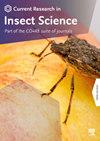Temperature-dependence of life history in an edible cricket: Implications for optimising mass-rearing
IF 2.7
Q1 ENTOMOLOGY
引用次数: 0
Abstract
Optimisation of life history and organismal performance underlies success in insect mass-rearing. Rearing schedules, resource use and production yield depend on many aspects of insect fitness and performance within and across generations, such as growth, development, longevity, and fecundity, which are all temperature dependent. Despite this general understanding, we often lack species-specific information needed to make informed decisions about manipulating rearing temperatures to optimise insect growth and development. Here, we characterise the effects of rearing temperature on nymph to adult development and lifespan (20 – 38 °C), and reproductive output (30 – 38 °C) in a farmed cricket (Gryllodes sigillatus). Crickets grew larger and reached adulthood sooner at higher developmental temperatures at the expense of longevity. Reproductive output was similar across a range of temperatures but decreased at 38 °C. Therefore, while temperature control is necessary to maximise production rates, temperature is unlikely to affect production yield in a fixed harvest cycle provided it is maintained within the narrow range enabling both fast growth and stable reproduction (32 – 36 °C). Our study provides a fundamental basis for further optimisation of insect rearing operations and a deeper understanding of the thermal biology of this commonly farmed species.
食用蟋蟀生活史的温度依赖性:优化大规模饲养的意义
优化生活史和有机体性能是昆虫大规模饲养成功的基础。昆虫的生长、发育、寿命和繁殖力等许多方面都与温度有关,而昆虫的饲养计划、资源利用和产量取决于昆虫在代内和代间的适应性和表现。尽管有这种普遍的理解,但我们经常缺乏对操纵饲养温度以优化昆虫生长和发育做出明智决定所需的特定物种信息。在这里,我们描述了饲养温度对养殖蟋蟀(Gryllodes sigillatus)若虫到成虫发育和寿命(20 - 38°C)以及繁殖产量(30 - 38°C)的影响。蟋蟀长得更大,在更高的发育温度下更快地成年,但代价是寿命的延长。生殖产量在不同温度范围内相似,但在38°C时下降。因此,虽然温度控制对提高产量是必要的,但在固定的收获周期内,温度不太可能影响产量,只要保持在能够快速生长和稳定繁殖的狭窄范围内(32 - 36°C)。我们的研究为进一步优化昆虫饲养操作和深入了解这一常见养殖物种的热生物学提供了基础。
本文章由计算机程序翻译,如有差异,请以英文原文为准。
求助全文
约1分钟内获得全文
求助全文
来源期刊

Current Research in Insect Science
Agricultural and Biological Sciences-Animal Science and Zoology
CiteScore
3.20
自引率
0.00%
发文量
22
审稿时长
36 days
 求助内容:
求助内容: 应助结果提醒方式:
应助结果提醒方式:


